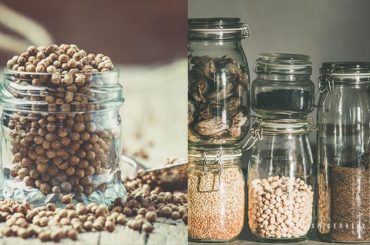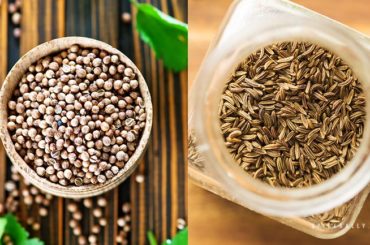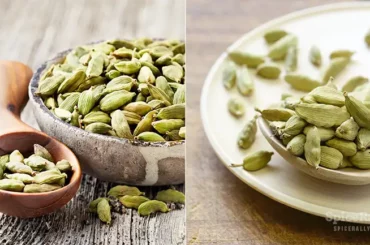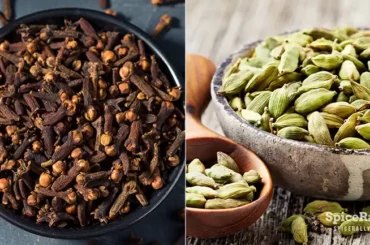You might have a jar of whole allspice berries and a container of ground allspice, and also a few Allspice leaves in your kitchen right now. And, you might be thinking about what you could possibly do with them. In fact, allspice usage in cooking is not as complex as you feel when you can match the right ingredients with the proper form!
Allspice is a versatile spice that is used with an assortment of sweet and savory dishes, spice blends, and seasonings. The dried berries are used either whole or powdered, and the leaves are also a spotlight in a number of savory dishes.
So, if you are ever in doubt, not been able to figure out how to use the whole spice, ground allspice, and the leaves of this plant, we are right here to clear all your confusion. Make sure you read until the end of our article to learn everything regarding allspice usage in cooking.
Allspice Usage In Cooking
Allspice is a spice that adds flavor, aroma, and texture to your meals pinch by pinch. It is all-around, coming with two forms as whole or ground, making it very easy for you to choose what type should be used in different recipes.

Apart from whole or ground allspice, leaves of the allspice tree are also employed in a number of dishes. However, when you have allspice in your spice rack, it is like you have several flavors in just one single container.
Allspice’s warm, earthy, sweet, spicy, and peppery flavor and aroma are pretty intricate and call for many palatable savories and sweet dishes making them real treats. It is also a key element in many popular spice blends and seasonings around the world.
This spice is mainly featured in Caribbean cuisine and has a special place in Middle Eastern, Arab, and some parts of European cuisines. And now it has gradually reached towards US and UK cuisines, making it a key component of many spicy dishes, desserts, and baked goods.
Some popular dishes that feature allspice are:
- Kinds of ketchup
- Jams
- Chutneys
- Moroccan tagines
- Mulled wine
- Jamaican Jerk seasoning/paste
- Herring
- Gingerbread
- Thanksgiving Pumpkin Pie
- Christmas cake
- Christmas pudding
- Apple Pie
- Dark Chocolate Desserts
- Stews
- Sausage dishes
- Meatball dishes
If you feel like having a sophisticated knowledge of this amazing spice, you are just one tap away from here to our exclusive feature on allspice.
Usage Of Whole Allspice Berries In Cooking
Dried whole allspice berries are widely available in the market. And they are best with dishes such as:
- Slow-cooked curries
- Stews
- Mulling
- Soups
- Pickles
- Braises
- Gravies
- Simple syrup
- Stocks
- Brines
- Sauces
When added in such recipes, the cinnamon-y, nutmeg-y, and clove-y flavor of allspice berries get well-infused with the particular dish.
Using two or three whole allspice berries will also add an in-depth flavor to your pot of chai or when making glühwein(Mulled wine, also known as spiced wine). And, when they are combined with cinnamon sticks and citrus fruits like oranges, the taste of your beverages will simply elevate to the next level!
Whole allspice berries also complement meat dishes very well. Tomatoes, onions combine with allspice, and beef to make delicious Cincinnati Chili. These chili dishes make lovely mates with spaghetti and meatballs. Brining liquids that allspice is included gives the perfect savory juiciness to big cuts of meat like pork roasts, whole chickens, or turkey.
Ground Allspice Usage In Cooking
In the USA, more than whole allspice berries, it is ground allspice that you can find mostly in the market. In fact, a tiny dash or a sprinkle of powdered allspice can go a long way. The flavor of the ground form is more intense than that of whole allspice berries. But still, the taste and aroma tend to lose quicker than the whole berries.
There is nothing better than the powdered form for desserts, cookies, puddings, biscuits, and other sweet baked goods. The powdery texture is easy to blend through the batters and doughs to give an overall taste.
However, it is always the ground allspice that goes into the spice blends and seasonings. As mentioned on top, this flavoring has become a key ingredient in many spice blends and seasonings such as:
- Jamaican Jerk Seasoning
- Pumpkin Pie Spice Mix
- Apple Pie Spice Mix
- Jamaican Jerk Seasoning
- Lebanese Spice Blend
- British Mixed Spice Mix
- Moroccan Spice Blend
- Jamaican Mixed Spice For Baking
Ground allspice is also used in molasses cookies and baked custard. Fruit pies become delectable when this spice is added. And it has the power to neutralize the sweetness of the fruits contained in the pies. Go ahead and try a pinch or two in your homemade jams and sweet chutneys to give a kick of warmth, flavor, and aroma.
Dishes With Ground Allspice
As mentioned before, this spice is a must-have in many stews, spice mixes, and meat in the Caribbean and Middle Eastern cuisines. When blended with ground nutmeg, ground cinnamon, powdered cloves, and ginger powder, allspice becomes an excellent flavoring in many fruit cakes, winter puddings, Christmas puddings, and gingerbreads. And in Greek cuisine, ground allspice is integrated with a number of marinades and spice rubs and is involved in strengthening the flavor of the tomato sauce.
Furthermore, ground allspice can also be sprinkled on top of your bowl of yogurt, oatmeal, roasted vegetables, or cup of coffee for added flavor. Try a pinch even with your iced coffee or hot chocolate to enrich the flavor.
Try these recipes made using ground allspice used as one of the main ingredients:
- Jamaican Jerk Chicken Wings
- Tuscan-Style Grilled Pork Chops with Balsamic Glaze
- Allspice Cream Cheese Frosting
- Allspice Grilled Squash
- Spiced Beef with Onion and Allspice Gratin
- Old-Fashioned Ginger Spice Cookies
Allspice Leaves Usage In Cooking
Allspice leaves are famous for smoking meat. And, they also add flavor to Indian dishes like Biryani, replacing their typically used ingredient- bay leaves.
Moreover, allspice leaves have a special place in the heart of Caribbean cuisine. Apart from their intensive usage of allspice berries in cooking, they include the leaves in many of their soups, sauces, stews, and even in the Jamaican Jerk seasoning.
What Are The Other Spices And Herbs That Allspice Blends Well With?
Interestingly, the aroma and flavor profile of allspice go well with many other spices and herbs that couple with cinnamon, nutmeg, cloves, and black pepper. This is mainly because of its subtle taste and smell, which is close to that of the flavors and aromas of the spices mentioned above.
Therefore, matching and combining allspice with other herbs and spices won’t be much of a challenge for you when cooking. Let’s see what other flavorings team up better with allspice. They include:
- Cinnamon
- Ginger
- Nutmeg
- Cloves
- Black pepper
- Cumin
- Coriander
- Chili powder
- Paprika
- Garlic powder
- Rosemary
- Thyme
- Lime juice
- Vinegar
Other cooking ingredients that make good couples with whole allspice berries, ground allspice, and allspice leaves are:
- Chicken
- Pork
- Turkey
- Beef
- Lamb
- Beetroots
- Onions
- Sweet potatoes
- Cauliflower
- Green beans
- Cucumbers
- Squash
- Apples
What Should I Use? Ground Allspice Or Whole Allspice Berries?
Well, now, this is a tricky thing when you are trying to cook something with both in your hands! You may have many questions as to what you should use where and if you can use ground allspice and whole allspice interchangeably and so on.
You already know how ground allspice is made. And, it is, in fact, the pulverized form of the whole allspice berries. Therefore, if you read the sections we have individually discussed the usage of whole berries and the ground form, you might already have an idea what to use when, and where.
It is just a matter of the texture of both forms. To be direct, ground allspice goes well with dishes that require a quick overall blending. However, it is not rocket science which is hard to understand that whole berries are challenging to mix through batters, doughs, or marinades. Therefore, ground allspice works well with:
- Spice blends
- Seasonings
- Dry spice rubs
- Marinades
- Desserts
- Cookie, biscuits, or cake batters and doughs
- Sprinkles
While on the other hand, whole allspice berries are best with slow-cooked dishes that take time for spice infusions. For example, when whole berries are added with soups, stews, or slow-cooking meat dishes, they will infuse with other spices and herbs to give a better taste to the entire meal.
Consequently, apart from texture and versatility, you have no other obstruction in using these two interchangeably. You can either buy ground allspice from the store or bring whole berries and grind them using your spice grinder whenever you want. The choice is all yours!
Using matching ingredients with matching spices bring soul even to the blandest dishes
anonymous
Whatever The Form You Use, Allspice Is A Faithful Cooking Companion…
Dear readers, never, ever underestimate allspice’s ability to flavor your meals! We hope you understand why we say this if you read our article thoroughly.
True to the words, allspice is a great cooking companion to you, giving its ultimate flavor and aroma to many sweet and savory dishes that you make with love.
The only thing you must know is when to use what form- either whole allspice berries, powdered form, or the leaves. And if that was your main problem so far, we believe that you got everything answered from this feature.




